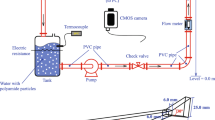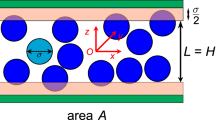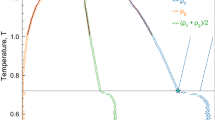Abstract
THE diaphragm-cell technique, first introduced by Northrop and Anson1, has been widely used as an experimental method of utilizing Fick's first law to obtain diffusion coefficients in liquids. The procedure is a simple one whereby diffusion takes place through a porous diaphragm separating two cells in which the respective liquid concentrations, initially different to provide a driving force or potential for diffusion, are maintained uniform. It is made clear by Gordon2 in his classical review of the experimental and theoretical basis of the method that certain simplifying assumptions must be made in its utilization. These assumptions include constant solution volumes and constant fluxes throughout the porous diaphragm at any given moment. In measurements involving dilute solutions of electrolytes, the errors introduced by these assumptions have been analysed2,3 and found to be unimportant. In the present work the magnitude of the error introduced by the second assumption was assessed for typical diaphragm diffusion cell conditions (including consideration of a binary non-electrolyte system). Dropping this assumption, the resulting system of differential equations was solved by a numerical method. Comparison of the times required to produce a given concentration change with and without the above assumption showed a difference of not more than 0.02 per cent. The first assumption of constant solution volumes, however, may introduce significant error whenever the system is one that displays volume change on mixing. The importance of accurate liquid diffusion coefficients has led us to replace, with a more general expression, the simple logarithmic equation, given by Gordon2, that applies admittedly only if there is no change in volume on mixing :  where c′ and c″ are concentrations, and v′ and v″ are volumes of the half-cells, ƒ and i refer to final and initial states respectively, A and l are the effective path area and length respectively, and β is the ‘cell factor’.
where c′ and c″ are concentrations, and v′ and v″ are volumes of the half-cells, ƒ and i refer to final and initial states respectively, A and l are the effective path area and length respectively, and β is the ‘cell factor’.
This is a preview of subscription content, access via your institution
Access options
Subscribe to this journal
Receive 51 print issues and online access
$199.00 per year
only $3.90 per issue
Buy this article
- Purchase on Springer Link
- Instant access to full article PDF
Prices may be subject to local taxes which are calculated during checkout
Similar content being viewed by others
References
Northrop, J. H., and Anson, M. L., J. Gen. Physiol., 12, 543 (1929).
Gordon, A. R., Ann. N.Y. Acad. Sci., 46, 285 (1945).
Barnes, C., Physics, 5, 4 (1934).
De Groot, S. R., “Thermodynamics of Irreversible Processes” (Interscience Pub., New York, 1951).
Bird, R. B., in “Advances in Chemical Engineering”, 1 (Academic Press, New York, 1956).
Author information
Authors and Affiliations
Rights and permissions
About this article
Cite this article
DULLIEN, F., SHEMILT, L. Equations for determining Diffusion Coefficients in Liquid Systems by the Diaphragm Cell Technique. Nature 187, 767–768 (1960). https://doi.org/10.1038/187767a0
Issue Date:
DOI: https://doi.org/10.1038/187767a0
This article is cited by
Comments
By submitting a comment you agree to abide by our Terms and Community Guidelines. If you find something abusive or that does not comply with our terms or guidelines please flag it as inappropriate.



